|
Stan Sayres, was an
automobile salesman in a Pendleton, Oregon, agency,
when first stepped into a power- boat in 1926. It was
an outboard hydroplane that had just done a flip on
Lake McKay, dousing its driver who, after swimming
ashore, said, "I'm through with boats."
Stan took him
literally, bought the craft, hauled it out of the lake
and was started on a career in speed- boating that
eventually carried him to the top of the heap. For
five years, since that day on June 6, 1950, when Slo-mo-shun
IV spead through that electronically operated trap off
Sand Point at an average speed of 160-323 miles an
hour, she's held the world's speed mark.
It
all began to click in mid 1947 when Stan Sayres & Ted
Jones got together to design a new hydroplane, to
incorporate radical aircraft design principles.
After the design was complete, Stan took the drawings
to Anchor Jensen to look them over and asked if he
would build the new boat.
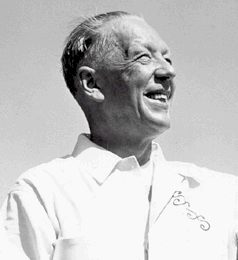
Stan
Sayres - owner Slomoshun
At the time Jensen Motor Boat was very busy, building
and repairing US Coast Guard and Navy vessels. Anchor
told Stan that under the pressure of their current
contracts, there was no way he could fit another
project in at that time. And that he really didn't
like the design of the boat especially the form of the
sponsons.
So Ted Jones agreed that he could
build the boat at his home. However, some seven
months later it became obvious Ted was not keeping
pace with the tight build schedule, whereupon Stan
went back to his old friend Anchor Jensen and see what
he could work out. So it was that Anchor agreed
to finish building the boat at JMC. And JMC did
get the job finished in a timely fashion following the
specifications set forth in the Jones design.
The boat was originally launched in October 1949,
without a tail. A tail simply hadn't been developed
far enough to be built.
In
the early days of Hydroplane Gold Cup racing
every competitor in the race had to be sponsored by a
yacht club. Stan Sayres was a member of the Seattle
Yacht club and they sponsored the Slo-mo-shun IV in
the 1950 Gold Cup and Harmsworth trophy races, and
continued to sponsor both the IV and V until they
finished competing under Stan Sayres ownership
When SYC's Stan Sayres
and Slo-mo IV showed up in Detroit in the
summer of 1950, nobody paid much attention until he
qualified for the Gold Cup Race. The win gave Sayres
the right to bring the next race to his yacht club. A
meeting at SYC attracted about 100 people, and the
club agreed to take on the responsibility. The first
chairman was Jerry Bryant, owner of the largest marina
in the area and veteran outboard racer. He opened the
meeting with: "We don't know the first damn thing
about putting on an unlimited hydroplane race, but we
are going to do it."
A
Perfect Day For Speed
From
July 21 to 23, 1950, due to rough water and a broken
propeller, Sayres' first attempts at world record runs
failed. But in the early morning hours of June 26,
lake conditions, with a light chop on the water, were
perfect for speed. At 5:30 a.m. boats went out along
the measured one-mile course and picked up any debris
they could find. At about 6:45 the course was ready
and the Slo-mo-shun IV, with Sayres and
crewmember Ted Jones, headed out.
On
the first attempt, the timer malfunctioned. The Slo-mo-shun
IV continued to the south end of the course, and
turned north. Sayres opened the throttle, and the
hydroplane ate up the mile in 21.98 seconds (163.785
mph). For an official speed run, rules required the
boat to make a second try within 15 minutes, going in
the opposite direction. The Slo-mo-shun IV
refueled in seven or eight minutes. Sayres then
pointed the hydroplane south and zipped over the
course at 157.2 mph. The combined times were averaged
to establish a speed of 160.3235 mph.
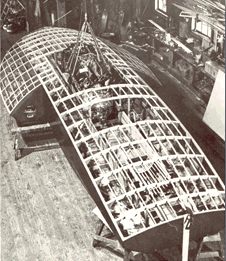
Slomoshun
- under construction
On July 7, 1952, in
East Channel between
Mercer Island and the mainland with Sayres again at
the belm, she stepped that world mark up to 178.497
miles an hour. Going back to 1950, Slo-mo-shun
IV made her trip to Detroit. First, with Ted Jones,
her designer**(see notes) at the wheel, she won the
Gold Cup which now rests in the trophy case of the
Seattle Yacht Club.
Two weeks later, with
Lou Fageol driving in the place of Ted Jones who had
broken a hand, she defended successfully the
Harmsworth Trophy, the world's championship emblem,
and brought that to the Seattle Yacht Club, too.
And in the four
following years either Slo-mo IV (she won in '52 and
'53) or So-mo V (winner in '51 and '54) shared the
emblem of the speedboat championship of the United
States and the world and they have remained in
Seattle.
All that marvelous
record started from that overturned outboard Stan
Sayres picked up on Lake McKay. During the next few
years he did quite a bit of outboard racing*(see
Notes)himself, top speed 40 miles an hour. Not much as
compared to the 178.497 miles an hour he now has
driven Slo-mo IV. But the bug had taken
and when Seattle became his home, Lake Washington his
constant bidder for the thrills of speed-boating, his
creative mind went to work.
First came Slomoshun, a
second- hand 225-cubic-inch inboard he picked up. He
got speeds up to 83 miles an hour out of that one. But
the competition*(see notes)during the depression years
(he bought Slomoshun in 1937) was limited. She burned
and sank off Sheridan Beach one day and a charred
piece of a rib from her hull is all Stan Sayres has to
rernind him.
Second came another
used boat, named Slomo II, which turned up 91.8 in her
fastest time, but still didn't meet the requirements
Stan Sayres wanted.
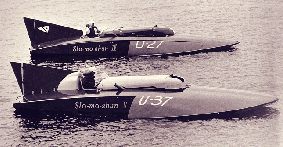
Slomoshun
- World water speed record holder 1950 - 1952
Slo-mo-shun III, with a
souped-up automobile engine and a specially designed
hull, came next, is still running, having been sold to
an Easterner. With her Sayres got up to 96 miles*(see
notes) an hour. The bug had really bitten by that time
and the plan to go into a bigger and faster boat began
to take form. Ted Jones, the designer*, and Anchor
Jensen, the builder*, came into the picture with
Sayres in 1948.
Slowly the ideas were
worked over, some so radical that when experienced
boat builders saw the fashioned Slo-mo-shun IV they
were dumbfounded. One even swore it wasn't a boat but
an airplane. She was finished and
ready for the water in October, 1949, had all her
preliminary runs on Lake Washington. Slowly, the word
got out that a true speed demon had been developed.
More than one Lake
Washington resident and boat enthusiast gazed
goggle-eyed as Slo-mo IV, her 30' high rooster tail
flying behind her, sped up and down the lake. Changes were made until perfection was reached*(see
notes)and then the request for sanction for an attempt
on the world mark, then held by the late Sir Malcolm
Campbell, the Englishman, of 141.74 miles an hour.
On June 26 with only a
handful of people on hand- the fame of the boat wasn't
established as yet, nor had Seattleites awakened to
the thrill of her or the whine of her marvelous
Seattle-built (by Western Gear)*(see notes)gear box
-she made her debut. With Mel Crook,
associate editor of Yachting, as the referee
representing the American Power Boat Association, and
the modern, electrically operated timing devices
approved by APBA checking her, Slo-mo-shun IV startled
the whole boating world.
Speedboat men looked at that 160.323
miles an hour they saw in their morning newspapers and
gasped. The Sayres family, with that astounding run,
were literally catapulted into a limelight they had
never thought of.
To a home-loving,
modest woman like Madeline Sayres it was an experience
almost terrifying at times, even with her
graciousness. And to Stan Sayres, actually shy to an
almost self- effacing point, it was a situation that
grew and grew, that placed on his shoulders not only
the need to face scores of calls for talks on his
great boat but correspondence and demands for
photographs that kept him and two stenographers busy
for weeks.
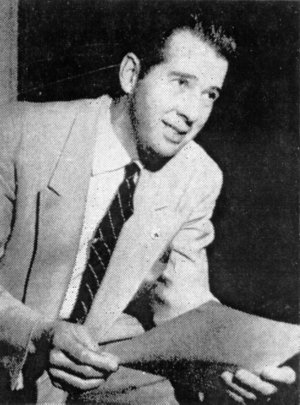
Ted
Jones - designer slomoshun
Gold
Cup entrants know this. But no one knows it better
than a Gold Cupper named Tudor Owen Jones, a hand
some, husky man of 45 with flecks of gray in his dark
hair, who has had more to do with this year's Gold Cup
entries than any man alive. As a young mechanic in
Seattle's Boeing aircraft plant, Ted Jones conceived
the original design from which virtually every one of
this year's boats was copied. As chief architect for
Stanley Sayres (Sports Illustrated, Aug. 23,
1954), a wealthy Seattle automobile distributor, he
designed the Slo-Mo-Shuns IV and V that
have won the Cup for the past five years and set two
world speed records to boot; and Jones himself drove Slo-Mo
IV to her first Gold Cup victory in 1950.
Victories
are fine, but Ted Jones wants credit-and headlines. In
the world of the Gold Cup however, the headlines go
not to the designer but to the owner. In 1951, for
example, Jones says Slo-Mo IV was judged the
greatest mechanical design of the year and that Owner
Sayres took the award, forgetting to credit his
designer. Jones was furious. That year and the next,
while Slo-Mo V was taking shape from Jones's
design in the boatyard of Builder Anchor Jensen in
Seattle, a three-cornered feud developed involving
credit, authority and, of course, money.
Jones
has dedicated his life to speedboat design. He began
when he was a boy of 17, building first an outboard
racer, then a 14-horse-power water sled that he used
to run at 33 Ales per hour through the rolling wake of
the passenger boats that plied between Seattle and
Tacoma. He also puttered around on land with a
motorcycle and a hopped-up Model T, both of which he
raced.
At
this point, Sayres himself was still happy, and lyric
in his praise, not only of Designer Jones, but also of
Race Driver Jones. "His technique," says
Sayres, "is perfect. His is sound, fearless and
careful, all at the same time. His reactions are
instantaneous, his coordination perfect."
Forthwith, be presented Jones with a brand new
Chrysler from the well-stocked Sayres automobile
agency. That was the end of the bouquets.
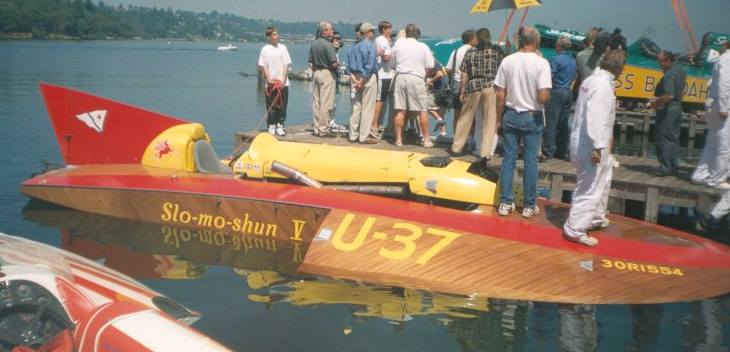
Slo-mo-shun
V - U37
Just
before the race Jones and Sayres had entered into a
written contract, which granted Jones $500 for his
work, and prevented him from designing boats for Gold
Cup rivals. Jones says Sayres wanted it for tax
reasons. Sayres says Jones wanted it to give himself
final say in all matters of design. Neither one seems
to have been very happy with it.
Again,
lessening of love did not prevent the uneasy trio from
planning bigger and better speedboats. No sooner was
the Gold Cup brought safely to Seattle than Sayres and
Jones started planning how to keep it there. Slo-Mo
IV was the fastest boat in the world on a
straightaway; and she turned fairly well. But if they
could get a boat that would accelerate a little
faster, turn a little tighter, and hold speed on a
straight, Detroit would be a long time getting its cup
back. Jones quit Boeing and applied himself full time
to the project. The result: Slo-Mo V.
There
was one other result, a second contract, this one
verbal but subsequently just as unsettling as the
written document that went with Slo-Mo IV. By
the terms of the agreement, Jones got a flat fee of
$5,000 for his plans, plus $500 per month while
working on the V at Jensen's. This arrangement
seems to have made Jones feel too much like a hired
hand, and not enough the man behind the boat.
Nonetheless, the trio managed to hold together? long
enough to see Slo-Mo V win the 1951 Gold Cup.
Buts a few months later Jones left Sayres to take a
$1,000-amonth traveling job with Carl Kiekhaefer,
president of the company that makes the Mercury
outboard motor.
Please
note the above story has been complied from several
opposing accounts of the Slomoshun boat, its tean and
development. We have tried to give an unbiased
account, so as not to offend any surviving party or
their families. Please feel free to comment, if
we have posted any material fact incorrectly.
SLOMOSHUN
RESULTS:
|
Date
|
Place
|
Event
|
Driver
|
Result
|
Speed
MPH
|
|
6-26-50
|
Seattle
|
World's
Straightaway Record
(Average speed of two runs in opposite directions)
|
Stan
Sayres
|
New
Record
|
160.323
|
|
7-22-50
|
Detroit
|
Gold
Cup Race
(3 statute Mile Course)
(90 miles-3 Heats
|
Ted
Jones
|
Won
All 3 Heats,
New HeatRecord (80.892 mph)
New RaceRecord (78.215 mph)
|
|
|
8/1/50
8/2/50
|
Detroit
|
The
Harmsworth or British
International Trophy
(5 nautical mile Course)
(90 N. Miles-Two heats)
|
Lou
Fageol
|
Won-All
Heats
New Lap Record (102.676 mph)
New Heat Record (100.680 mph)
New Race Record (95.623 mph)
|
|
|
8/4/50
|
Detroit
|
Silver
Cup Race
(Won First Heat)
(Cracked Diveshaft)
(Out Of other heats)
|
Lou
Fageol
|
Won
First Heat
|
104.677
|
|
6/17/51
|
Pendelton
|
Exhibition
(5 statute Mile Course)
|
Stan
Sayres
|
1
lap at (111.43 mph)
3 laps at (110.89 mph)
|
|
|
8/12/51
|
Seattle
|
Seattle
Seafair Trophy Race
(Fastest Time Ever Run in Competition)
|
Lou
Fageol
|
Won
2nd Heat
New Lap record (112.530 mph)
New Heat record (111.742 mph)
|
|
|
9/2/51
|
Vancouver
BC
|
Exhibition
"Match Race IV & V"
|
Jones
"IV"
Sayres "IV"
|
Jones-Won
First(90.864mph) HeatSayres-Won 2nd Heat
2nd lap at (110.652 mph)
|
90.864
|
|
7/7/52
|
Seattle
|
World's
Straightaway Record
(Average of two runs in opposite directions)
(South run made at 185.567)
|
Stan
Sayres
|
New
Record
|
178.497
|
|
8/9/52
|
Seattle
|
Gold
Cup Race
(3 Statute Mile Course)
(90 mile-3 Heats)
(Race speed curtailed by
critical accident)
|
Dollar
|
Won
Two Heats
Out of Third Heat
Race Average (79.92)
|
|
|
9/9/53
|
Seattle
|
Gold
Cup Race
(3 3/4 Statute Mle Course)
(90 miles-3 heats)
|
Taggart
Fageol
|
Won
all heats
Fastest Lap (104.231)
New Heat Record (95.268)
New Race Record (92.571)
|
|
Ted
Jones, the man who creating
the Slomoshun IV & V died in January of 2000
Ted was an extremely
talented man, and some of his ideas helped change the nature
of hydroplane racing forever. For his contributions as an
original member of the team that created the Slo-mo-shun
IV & V and his many boats & accomplishments
thereafter, he has carved out a well earned place in the
hearts and minds of
everyone in
the world who has ever enjoyed the sport he loved so much.
He will be missed and never forgotten.
Anchor
Jensen, World Renowned Master Shipwright Dies in Seattle
Anchor
was an artist, designer, intuitive genius, master
shipwright, builder and healer of thousands of boats.
Boats that went to war, boats that went to work, boats
that broke world records, and won Seattleís heart and
the Gold Cup 5 times. Thatís a lot to say about a man,
but someone had to say it ,because he never would. A
friend of Anchors told me when I asked him, "what was
he like as a child"? His response was " the same
as he is today , a man of few words, always thinking
always working".
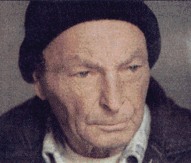
Anchor
Jensen - builder Slomoshun
Anchor
was born July 25, 1918, in Victoria British Columbia. His
father Antonius (Tony) Jensen was a musician who loved
boat building, his mother the beautiful and industrious
daughter of a well respected Victoria doctor. Anchor, the
second of two children, couldnít have been given a more
appropriate name. He lived up to it every day. I realized
today as I was writing this, that as I look back over his
life I donít think he has ever been away from the water
or a boat for more then a couple of days in his entire
life. The day he was born his dad was working on the Tony
Boy in the backyard of their home, When they left Victoria
when Anchor was seven they didnít drive or take a train,
they cruised down Puget Sound, on the Tony Boy.
When
they reached Seattle, Anchorís Family didnít move into
a house they lived aboard the boat, next to the Queen City
Yacht club on Portage Bay where Tony and Bessie had
purchased property to build a boat yard. When Anchor
started Grammar School at Seward and then Laurelhurst he
commuted by boat and foot. When it came time to move off
the Tony Boy, the family didnít bother to move to dry
land, Tony had built them an apartment on the second floor
of the first building of the Jensen boat yard, established
in 1927, which was located out over the water, with a ramp
leading up to dry land. When Anchor enlisted for WWII he
graduated with honors at the top of his class at Great
Lakes Naval Training Center and served with honor in the
Navy aboard the Battleship Iowa and the USS Belleau Wood.
When he married Ann Katheryn Clarke in September 1950,
they went to Hawaii, God knows, they could have flown, but
not Anchor they had to take a cruise ship the Lauraleane.
Anchor
spent his entire life immersed in learning about boats and
how they perform on water. Even yesterday when he became
seriously ill he was at the boat yard. The same yard he
has lived and worked at all his life. In addition to being
co-designer and builder of Slo-mo-shun IV and V which set
World Speed Records in 1950 and 1952 he also managed and
owned the Jensen Motor Boat Company for the last 63 years.
During this time they built hundreds of classic wooden
custom boats and rebuilt thousands of others. Anchor was a
life long member of the Mountaineers, a past member of the
Seattle and Corinthian Yacht Clubs, member of the APBA and
many other organizations. He is the recipient of numerous
awards for his life long contribution , not only for his
pioneering innovations in the world of Hydroplanes but
also for his commitment and contributions to the northwest
boat building community. Anchor had the perfect name and
made living up to it a matter of personal pride. He
will be remembered worldwide for his creations the Slo-mo-shun
IV and Slo-mo-shun V.
"Of
records and record breakers, I would remind you that speed
is relative to time. What we consider slow now, was
unthinkable in years gone by. However, each time a
contender goes out onto the field of battle, he or she
faces the same hurdles, the same fears and financial
challenges as those before us, and most importantly of
all, has to muster themselves to boiling point make it all
happen. In the end, players will either triumph or
fail, but in doing so, show others where to, and where not
to tread. All too often players pay the ultimate
price. Whether they raise Man's technical mastery up
another notch or not, history should remember every last
one of them - for they were players." (Nelson
Kruschandl December 2005)

Nelson
Kruschandl
LINKS
:
Jensen
Motor Boat Company
Services
& Rates "On
The Ways"
Tony
Jensen Musician &
Founder JMC
George
Jensen Industrial
Designer
Anchor
Jensen Boat
Designer-Builder
Slo-mo-shun
IV History
A
history & Photo database of almost every boat built there.
Boat
Database
1922-29
1930-39
1940-49
1950-59
1960-69
1970-79
Email link
Hydroplanes
and Racing:
Hydrofest
Hyrdroplane
& Raceboat Musuem
World
Water Speed Records
Hydros
Seattle
Outboard Association
Classic
Wooden Boat
& Maritime sites
Classic
Boat Club
Woodies
on the web
Wooden
Boat Magazine
Mystic
Seaport
Classic
Yacht Association
Puget
Sound Maritime Society
Wooden
Boat Foundation
Seafair
Activities
Seattle
Seafair 2005
Seattle
Seafair Pirates
When
in need sites
Tugboats
Help
on the water
Washington
State Ferry Schedule
Coast
Guard
National
Weather Service
Maritime
News
48
North
Northwest
Yachting
Nautical
Books
Armchair
Sailor
|